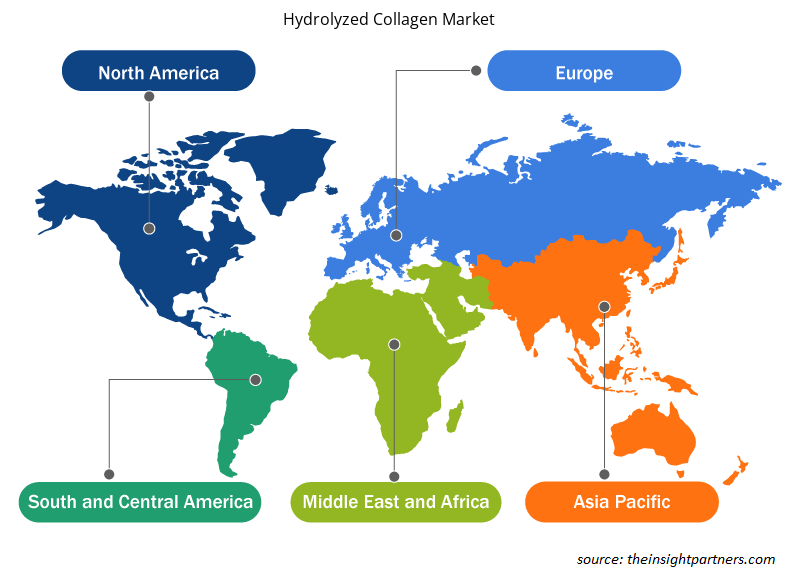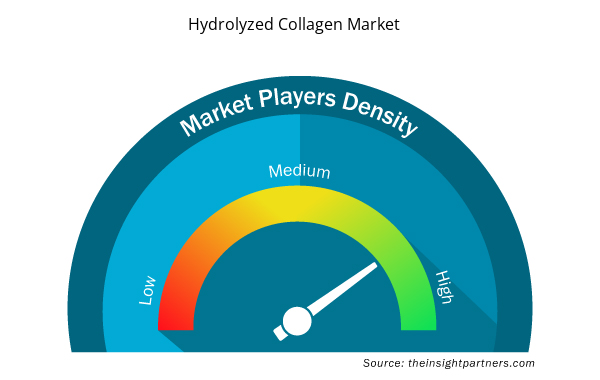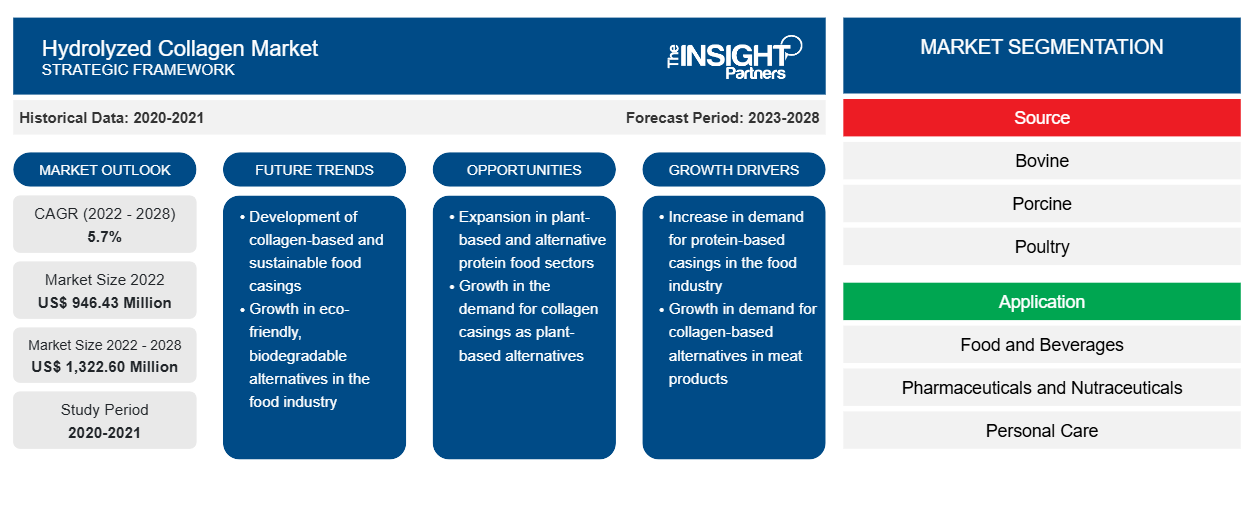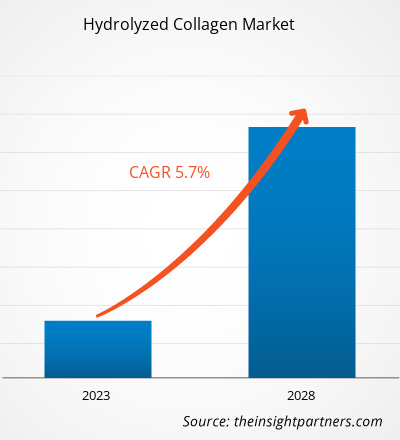[연구 보고서] 가수분해 콜라겐 시장 규모는 2022년에 9억 4,643만 달러였으며, 2028년에는 1,322.60만 달러에 도달할 것으로 예상됩니다. 2022년부터 2028년까지 연평균 성장률 5.7%를 기록할 것으로 예상됩니다.
가수분해 콜라겐은 생물의학 및 조직 공학 분야에서 중요한 응용 분야를 가지고 있습니다. 상처 드레싱 및 뼈 공극 필러를 포함한 다양한 의료 기기에 사용됩니다. 가수분해 콜라겐과 젤라틴은 강력한 세포 접착력, 생체 적합성 특성 및 높은 수준의 성형성을 가지고 있습니다. 가수분해 콜라겐은 많은 조직과 장기에서 눈에 띄는 세포외 기질 성분(ECM)입니다. 조직 형성과 적절한 조직 구조 및 기능의 보존에 중요한 역할을 합니다. 결과적으로 스펀지 및 젤과 같은 다양한 콜라겐 스캐폴드를 사용하여 세포 이식 캐리어가 개발되었습니다. 따라서 다양한 응용 분야에서 가수분해 콜라겐에 대한 수요가 증가함에 따라 시장 성장이 촉진됩니다.
2022년 북미는 글로벌 가수분해 콜라겐 시장 에서 가장 큰 점유율을 차지했으며 아시아 태평양은 예측 기간 동안 가장 높은 CAGR을 기록할 것으로 추정됩니다. 가수분해 콜라겐을 함유한 기능성 식품 및 음료는 피부를 강화하고 피부에 탄력과 수분을 제공하는 데 중요한 역할을 합니다. 또한 관절을 보호하는 연골의 무결성을 유지하는 데 도움이 됩니다. 따라서 가수분해 콜라겐 섭취와 관련된 이점과 변화하는 소비자 선호도 및 행동이 결합되어 이 지역 전체에서 가수분해 콜라겐 기반 건강기능식품에 대한 수요가 증가했습니다. 그 결과 영양 성분 분야의 많은 주요 업체가 확장에 집중하고 전략적 계획을 점점 더 많이 채택하고 있습니다. 예를 들어, 2020년 12월 Gelita AG는 터키 젤라틴 생산업체 SelJel을 인수했습니다. 이 합작 투자를 통해 Gelita AG는 가수분해 콜라겐 시장에서의 입지를 강화할 것입니다. 따라서 주요 업체의 전략적 이니셔티브 채택이 증가함에 따라 가수분해 콜라겐 시장 성장이 더욱 강화되었습니다.
귀하의 요구 사항에 맞게 이 보고서를 사용자 정의하세요
이 보고서의 일부 또는 국가 수준 분석, Excel 데이터 팩을 포함하여 모든 보고서에 대한 사용자 정의를 무료로 받을 수 있으며 신생 기업 및 대학을 위한 훌륭한 혜택과 할인 혜택을 이용할 수 있습니다.
- 이 보고서의 주요 시장 동향을 알아보세요.이 무료 샘플에는 시장 동향부터 추정 및 예측까지 다양한 데이터 분석이 포함됩니다.
COVID-19 팬데믹이 가수분해 콜라겐 시장에 미치는 영향
COVID-19 팬데믹은 전 세계 여러 국가의 경제와 산업에 영향을 미쳤습니다. 북미, 유럽, 아시아 태평양(APAC), 남미 및 중미(SAM), 중동 및 아프리카(MEA)의 봉쇄, 여행 제한 및 사업 중단은 식품 및 음료, 제약 및 건강기능식품, 개인 관리 산업을 포함한 여러 산업의 성장을 저해했습니다. 제조 단위의 폐쇄는 글로벌 공급망, 제조 활동, 납품 일정, 필수 및 비필수 제품 판매를 교란했습니다. 다양한 회사는 2020년에 제품 납품이 지연되고 제품 판매가 침체되었습니다. 게다가 유럽, 아시아 태평양 및 북미의 여러 국가 정부가 국제 여행을 금지하면서 회사는 일시적으로 협업 및 파트너십 계획을 중단해야 했습니다. 이러한 모든 요인이 2020년과 2021년 초에 다양한 산업을 저해하여 가수분해 콜라겐 시장을 포함한 다양한 시장의 성장을 제한했습니다.Lockdowns, travel restrictions, and business shutdowns in North America, Europe, Asia Pacific (APAC), South & Central America (SAM), and the Middle East & Africa (MEA) hampered the growth of several industries, including the food & beverages, pharmaceutical & nutraceutical, and personal care industries. The shutdown of manufacturing units disturbed global supply chains, manufacturing activities, delivery schedules, and essential and nonessential product sales. Various companies witnessed delays in product deliveries and a slump in sales of their products in 2020. Moreover, the bans imposed by governments of various countries in Europe, Asia Pacific, and North America on international travel compelled companies to discontinue their collaboration and partnership plans temporarily. All these factors hampered various industries in 2020 and early 2021, thereby restraining the growth of various markets, including the hydrolyzed collagen market.
시장 통찰력
주요 시장 참여자의 전략적 개발 이니셔티브가 가수분해 콜라겐 시장을 주도합니다.
전 세계의 가수분해 콜라겐 제조업체는 많은 소비자를 유치하고 시장 지위를 강화하기 위해 제품 혁신, 합병 및 인수, 사업 확장과 같은 전략적 개발 이니셔티브에 상당한 투자를 하고 있습니다. 그들은 고객 기반을 확대하고 새로운 소비자 트렌드를 충족하기 위해 제품 혁신에 점점 더 많은 투자를 하고 있습니다. 예를 들어, 2022년 3월, 호주에 본사를 둔 뷰티 브랜드 'Vida Glow'는 지속 가능하게 공급된 생선 가죽으로 만든 가수분해 콜라겐 펩타이드 분말에서 파생된 천연 해양 콜라겐 광채 캡슐을 출시했습니다. 또한 수요가 증가함에 따라 Vida Glow는 같은 달에 미국 시장으로의 확장을 발표했습니다. 게다가 가수분해 콜라겐은 이제 동물 영양 제조업체에서 영양 강화를 통해 반려동물 사료의 품질을 향상시키는 데 점점 더 많이 사용되고 있습니다. 예를 들어, 2022년 11월, 영국에 본사를 둔 제조업체인 Pawable은 개의 관절, 피부 및 소화 문제를 예방하는 분말 보충제인 "Collar-Gen"을 출시했습니다. 여기에는 5가지 유형의 100% 천연 가수분해 콜라겐이 포함되어 있습니다. 이러한 제품 혁신은 가수분해 콜라겐이 국제 시장에서 영향력을 확대하고 경쟁 우위를 확보하는 데 도움이 되며, 가수분해 콜라겐 시장 성장을 더욱 촉진합니다.Vida Glow' launched natural Vida Glow announced an expansion in the US market in the same month. Moreover, hydrolyzed collagen is now increasingly used by animal nutrition manufacturers to enhance the quality of pet food with nutritional enrichment. For instance, in November 2022, Pawable, the UK-based manufacturer, launched "Collar-Gen," a powdered supplement to prevent joint, skin, and digestive issues in dogs. It contains five different types of 100% natural hydrolyzed collagen. Such product innovations help hydrolyzed collagen extend its reach and gain a competitive edge in international markets, further propelling the hydrolyzed collagen market growth.
소스 기반 통찰력
출처에 따라 가수분해 콜라겐 시장은 소, 돼지, 가금류, 해양 및 기타로 구분됩니다. 소 세그먼트는 2022년에 시장에서 가장 큰 점유율을 차지했습니다. 콜라겐을 수용액에서 추출한 후 건조하고 분말화하여 최종 제품을 형성합니다. 소 콜라겐은 인체의 I형 및 III형 콜라겐 수치를 개선하는 것으로 밝혀졌습니다. 피부는 주로 I형 및 III형 콜라겐 으로 구성되어 있으므로 지정된 양으로 섭취하면 주름을 줄이고 탄력을 증진하며 피부 수분을 증가시키는 데 도움이 됩니다. 또한 소 폐에서 추출한 가수분해 콜라겐은 항염 및 항산화 특성을 보였습니다. 이러한 요인이 세그먼트 시장을 주도하고 있습니다.
애플리케이션 기반 통찰력
응용 프로그램을 기준으로, 가수분해 콜라겐 시장은 식품 및 음료, 의약품 및 건강기능식품 , 개인 관리 및 기타로 세분화됩니다. 식품 및 음료 부문은 예측 기간 동안 가장 높은 CAGR을 기록할 것으로 예상됩니다. 가수분해 콜라겐은 영양 바에 사용되는 재료의 결합제 역할을 하여 부드러움을 향상시킵니다. 건강 의식이 높아짐에 따라 식품 제조업체는 영양가 있는 식품을 개발하기 위해 가수분해 콜라겐을 선호합니다. 콜라겐 가수분해물은 칼슘 이온을 부착하여 생체이용률을 개선할 수 있습니다. 따라서 가수분해 콜라겐은 기능성 식품 성분에 사용하여 미네랄 결핍을 관리할 수 있습니다.CAGR during the forecast period. Hydrolyzed collagen acts as a binding agent for ingredients used in nutritional bars, enhancing their softness. As a result of increased health consciousness, food manufacturers prefer hydrolyzed collagen to develop nutritious food products. Collagen hydrolysates can attach calcium ions, improving their bioavailability. Thus, hydrolyzed collagen can be used in functional food ingredients to manage mineral deficiencies.
가수분해 콜라겐은 항응고제 역할을 하며 세포와 조직의 손상을 줄이는 데 도움이 되기 때문에 추위나 동결 온도에서 보관해야 하는 식품에 유익할 수 있습니다. 가수분해 콜라겐은 제품의 감각적, 물리적, 화학적 특성을 증가시키고 유지하는 데 도움이 됩니다. 따라서 위에서 언급한 특성으로 인해 가수분해 콜라겐은 고기, 음료, 수프와 같은 다양한 제품을 준비하는 데 사용되었습니다.sensorial, physical, and chemical properties. Thus, owing to the abovementioned properties, hydrolyzed collagen has been used to prepare different products such as meat, beverages, and soups.
가수분해 콜라겐 시장에서 활동하는 주요 기업으로는 Ewald-Gelatine GmbH, GELITA AG, Rousselot BV, Nitta Gelatin Inc, Protein SA, ConnOils LLC, Norland Products Inc, Tessenderlo Group NV, Titan Biotech Ltd, Viscofan DE GmbH가 있습니다. 이 회사들은 전 세계적으로 증가하는 소비자 수요를 충족하고 특수 포트폴리오에서 제품 범위를 늘리기 위해 신제품 출시와 지리적 확장에 집중합니다. 이들은 광범위한 글로벌 입지를 갖추고 있어 많은 고객에게 서비스를 제공하고 결과적으로 시장 점유율을 늘릴 수 있습니다.
가수분해 콜라겐 시장 지역 통찰력
Insight Partners의 분석가들은 예측 기간 동안 가수분해 콜라겐 시장에 영향을 미치는 지역적 추세와 요인을 철저히 설명했습니다. 이 섹션에서는 북미, 유럽, 아시아 태평양, 중동 및 아프리카, 남미 및 중미의 가수분해 콜라겐 시장 세그먼트와 지리에 대해서도 설명합니다.

- 가수분해 콜라겐 시장에 대한 지역별 데이터 얻기
가수분해 콜라겐 시장 보고서 범위
| 보고서 속성 | 세부 |
|---|---|
| 2022년 시장 규모 | 9억 4,643만 달러 |
| 2028년까지 시장 규모 | 1,322.60백만 달러 |
| 글로벌 CAGR (2022-2028) | 5.7% |
| 역사적 데이터 | 2020-2021 |
| 예측 기간 | 2023-2028 |
| 다루는 세그먼트 | 출처별
|
| 포함된 지역 및 국가 | 북아메리카
|
| 시장 선도 기업 및 주요 회사 프로필 |
|
가수분해 콜라겐 시장 참여자 밀도: 비즈니스 역학에 미치는 영향 이해
가수분해 콜라겐 시장 시장은 소비자 선호도의 변화, 기술 발전, 제품의 이점에 대한 인식 증가와 같은 요인으로 인해 최종 사용자 수요가 증가함에 따라 빠르게 성장하고 있습니다. 수요가 증가함에 따라 기업은 제품을 확장하고, 소비자의 요구를 충족하기 위해 혁신하고, 새로운 트렌드를 활용하여 시장 성장을 더욱 촉진하고 있습니다.
시장 참여자 밀도는 특정 시장이나 산업 내에서 운영되는 회사나 기업의 분포를 말합니다. 주어진 시장 공간에 얼마나 많은 경쟁자(시장 참여자)가 존재하는지 그 규모나 전체 시장 가치에 비해 나타냅니다.
가수분해 콜라겐 시장에서 활동하는 주요 기업은 다음과 같습니다.
- 에발트-젤라틴 GmbH
- 젤리타 AG
- 루셀로 BV
- 니타 젤라틴 주식회사
- 단백질 SA
면책 조항 : 위에 나열된 회사는 어떤 특별한 순서에 따라 순위가 매겨지지 않았습니다.

- 가수분해 콜라겐 시장 주요 주요 업체 개요를 알아보세요
스포트라이트 보고서
- 가수분해 콜라겐 시장의 진보적인 산업 동향은 기업이 효과적인 장기 전략을 개발하는 데 도움이 됩니다.
- 선진국과 개발도상국의 시장 참여자들이 채택한 사업 성장 전략
- 2022년부터 2028년까지의 시장에 대한 정량적 분석
- 가수분해 콜라겐에 대한 세계 수요 추산
- 가수분해 콜라겐 시장에서 구매자와 공급자의 효능을 설명하기 위한 포터의 5가지 힘 분석
- 경쟁 시장 시나리오를 이해하기 위한 최근 개발
- 가수분해 콜라겐 시장의 시장 동향 및 전망, 성장 동인 및 제약
- 상업적 이익을 뒷받침하는 시장 전략을 강조하여 의사 결정 프로세스 지원
- 다양한 노드에서의 가수분해 콜라겐 시장 규모
- 자세한 개요 및 가수분해 콜라겐 산업 역학
- 유망한 성장 기회를 가진 다양한 지역의 가수분해 콜라겐 시장 규모
- 역사적 분석(2년), 기준 연도, CAGR을 포함한 예측(7년)
- PEST 및 SWOT 분석
- 시장 규모 가치/양 - 글로벌, 지역, 국가
- 산업 및 경쟁 환경
- Excel 데이터 세트



Report Coverage
Revenue forecast, Company Analysis, Industry landscape, Growth factors, and Trends

Segment Covered
This text is related
to segments covered.

Regional Scope
North America, Europe, Asia Pacific, Middle East & Africa, South & Central America

Country Scope
This text is related
to country scope.
자주 묻는 질문
The major players operating in the global hydrolyzed collagen market are Ewald-Gelatine GmbH, GELITA AG, Rousselot BV, Nitta Gelatin Inc, Protein SA, ConnOils LLC, Norland Products Inc, Tessenderlo Group NV, Titan Biotech Ltd, and Viscofan DE GmbH
Surging Demand for marine-sourced hydrolyzed collagen to provide potential market opportunities in the coming years for the hydrolyzed collagen. Marine organisms such as fish, jellyfish, sponges, and other invertebrates harbor a significant source of hydrolyzed collagen. They are highly advantageous over other sources, as they are metabolically compatible, lack religious constraints, and are free of animal pathogens. Marine-sourced hydrolyzed collagen is majorly used for skincare product manufacturing. It is a versatile compound capable of healing skin injuries of varying severity and delaying the natural human aging process. Moreover, marine-sourced hydrolyzed collagen can be used as a biomaterial owing to its water solubility and metabolic compatibility. Thus, the demand for marine-sourced hydrolyzed collagen is increasing with its rising utilization for different industrial applications.
Based on source, bovine segments mainly have the largest revenue share. Bovine hydrolyzed collagen supplements may help counter the effects of low collagen levels. Boiling cow bones or other cattle byproducts in water produces this collagen type. After the collagen is extracted in an aqueous solution, it is dried and powdered to form a final product. Bovine collagen has been found to improve Type I and III collagen levels in the human body. The skin is primarily built up of Types I and III collagen; thus, its intake in specified quantities helps reduce wrinkles, promote elasticity, and increase skin moisture. Moreover, hydrolyzed collagen from bovine lungs showed anti-inflammatory and antioxidant properties. These factors are driving the market for the segment.
Strategic development initiatives by key market players are driving the hydrolyzed collagen market. Various end-use industries are adopting business expansion strategies and scaling production capacity to provide better customer satisfaction. For instance, in July 2020, Rousselot and Giusto Faravelli announced a distribution partnership in Italy, effective from October 2020. Under this partnership, Faravelli distributes food and pharmaceutical gelatins, hydrolyzed collagens, and biomedical gelatins across Italy. Thus, expanding businesses to other regions or countries to cater to the increasing demand by consumers drives the market growth. Such development strategies by hydrolyzed collagen manufacturers extend their reach and gain a competitive edge in international markets.
North America accounted for the largest share of the global hydrolyzed collagen market. Functional foods and beverages containing hydrolyzed collagen play a pivotal role in strengthening skin and providing elasticity and hydration to the skin. They also help retain the integrity of cartilage that protects joints. Therefore, benefits associated with the hydrolyzed collagen intake, coupled with changing consumer preferences and behavior, have fueled the demand for hydrolyzed collagen-based nutraceuticals across the region. As a result, many major players in the nutritional ingredients sector are focusing on expansion and increasingly adopting strategic planning.
Based on the application, food and beverages segment is projected to grow at the fastest CAGR over the forecast period. Hydrolyzed collagen is used in various food and beverages such as dairy products, confectioneries, and beverages. It improves the chewiness, foam stabilization, and texture of confectioneries. Additionally, in dairy products, it is used as a texturization and stabilization agent. Hydrolyzed collagen acts as a binding agent for ingredients used in nutritional bars, enhancing their softness. As a result of increased health consciousness, food manufacturers prefer hydrolyzed collagen to develop nutritious food products. Collagen hydrolysates can attach calcium ions, improving their bioavailability. Thus, hydrolyzed collagen can be used in functional food ingredients to manage mineral deficiencies.
Trends and growth analysis reports related to Consumer Goods : READ MORE..
The List of Companies - Hydrolyzed Collagen Market
- Ewald-Gelatine GmbH
- GELITA AG
- Rousselot BV
- Nitta Gelatin Inc.
- Protein SA
- ConnOils LLC
- Norland Products Inc.
- Tessenderlo Group NV
- Titan Biotech Ltd.
- Viscofan DE GmbH
The Insight Partners performs research in 4 major stages: Data Collection & Secondary Research, Primary Research, Data Analysis and Data Triangulation & Final Review.
- Data Collection and Secondary Research:
As a market research and consulting firm operating from a decade, we have published and advised several client across the globe. First step for any study will start with an assessment of currently available data and insights from existing reports. Further, historical and current market information is collected from Investor Presentations, Annual Reports, SEC Filings, etc., and other information related to company’s performance and market positioning are gathered from Paid Databases (Factiva, Hoovers, and Reuters) and various other publications available in public domain.
Several associations trade associates, technical forums, institutes, societies and organization are accessed to gain technical as well as market related insights through their publications such as research papers, blogs and press releases related to the studies are referred to get cues about the market. Further, white papers, journals, magazines, and other news articles published in last 3 years are scrutinized and analyzed to understand the current market trends.
- Primary Research:
The primarily interview analysis comprise of data obtained from industry participants interview and answers to survey questions gathered by in-house primary team.
For primary research, interviews are conducted with industry experts/CEOs/Marketing Managers/VPs/Subject Matter Experts from both demand and supply side to get a 360-degree view of the market. The primary team conducts several interviews based on the complexity of the markets to understand the various market trends and dynamics which makes research more credible and precise.
A typical research interview fulfils the following functions:
- Provides first-hand information on the market size, market trends, growth trends, competitive landscape, and outlook
- Validates and strengthens in-house secondary research findings
- Develops the analysis team’s expertise and market understanding
Primary research involves email interactions and telephone interviews for each market, category, segment, and sub-segment across geographies. The participants who typically take part in such a process include, but are not limited to:
- Industry participants: VPs, business development managers, market intelligence managers and national sales managers
- Outside experts: Valuation experts, research analysts and key opinion leaders specializing in the electronics and semiconductor industry.
Below is the breakup of our primary respondents by company, designation, and region:

Once we receive the confirmation from primary research sources or primary respondents, we finalize the base year market estimation and forecast the data as per the macroeconomic and microeconomic factors assessed during data collection.
- Data Analysis:
Once data is validated through both secondary as well as primary respondents, we finalize the market estimations by hypothesis formulation and factor analysis at regional and country level.
- Macro-Economic Factor Analysis:
We analyse macroeconomic indicators such the gross domestic product (GDP), increase in the demand for goods and services across industries, technological advancement, regional economic growth, governmental policies, the influence of COVID-19, PEST analysis, and other aspects. This analysis aids in setting benchmarks for various nations/regions and approximating market splits. Additionally, the general trend of the aforementioned components aid in determining the market's development possibilities.
- Country Level Data:
Various factors that are especially aligned to the country are taken into account to determine the market size for a certain area and country, including the presence of vendors, such as headquarters and offices, the country's GDP, demand patterns, and industry growth. To comprehend the market dynamics for the nation, a number of growth variables, inhibitors, application areas, and current market trends are researched. The aforementioned elements aid in determining the country's overall market's growth potential.
- Company Profile:
The “Table of Contents” is formulated by listing and analyzing more than 25 - 30 companies operating in the market ecosystem across geographies. However, we profile only 10 companies as a standard practice in our syndicate reports. These 10 companies comprise leading, emerging, and regional players. Nonetheless, our analysis is not restricted to the 10 listed companies, we also analyze other companies present in the market to develop a holistic view and understand the prevailing trends. The “Company Profiles” section in the report covers key facts, business description, products & services, financial information, SWOT analysis, and key developments. The financial information presented is extracted from the annual reports and official documents of the publicly listed companies. Upon collecting the information for the sections of respective companies, we verify them via various primary sources and then compile the data in respective company profiles. The company level information helps us in deriving the base number as well as in forecasting the market size.
- Developing Base Number:
Aggregation of sales statistics (2020-2022) and macro-economic factor, and other secondary and primary research insights are utilized to arrive at base number and related market shares for 2022. The data gaps are identified in this step and relevant market data is analyzed, collected from paid primary interviews or databases. On finalizing the base year market size, forecasts are developed on the basis of macro-economic, industry and market growth factors and company level analysis.
- Data Triangulation and Final Review:
The market findings and base year market size calculations are validated from supply as well as demand side. Demand side validations are based on macro-economic factor analysis and benchmarks for respective regions and countries. In case of supply side validations, revenues of major companies are estimated (in case not available) based on industry benchmark, approximate number of employees, product portfolio, and primary interviews revenues are gathered. Further revenue from target product/service segment is assessed to avoid overshooting of market statistics. In case of heavy deviations between supply and demand side values, all thes steps are repeated to achieve synchronization.
We follow an iterative model, wherein we share our research findings with Subject Matter Experts (SME’s) and Key Opinion Leaders (KOLs) until consensus view of the market is not formulated – this model negates any drastic deviation in the opinions of experts. Only validated and universally acceptable research findings are quoted in our reports.
We have important check points that we use to validate our research findings – which we call – data triangulation, where we validate the information, we generate from secondary sources with primary interviews and then we re-validate with our internal data bases and Subject matter experts. This comprehensive model enables us to deliver high quality, reliable data in shortest possible time.


 이 보고서에 대한 무료 샘플을 받으세요
이 보고서에 대한 무료 샘플을 받으세요